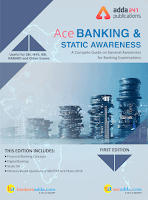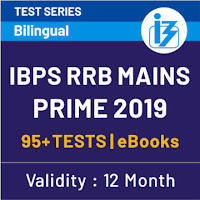IBPS RRB PO/Clerk Main Banking Awareness Quiz
Q1. निम्नलिखित में से कौन सा शब्द वित्त और बैंकिंग के क्षेत्र में उपयोग किया जाता है?
(a) Guage Pressure
(b) Quantum number
(c) Adjustment Credit
(d) Absolute Zero
(e) Single bond
Q2. जीएसटी एक अप्रत्यक्ष कर है जिसने भारत में कई अप्रत्यक्ष करों को बदल दिया है। माल और सेवा कर अधिनियम 29 मार्च 2017 को संसद में पारित किया गया था. अधिनियम लागू हुआ था-
(a) 1 जुलाई 2016
(b) 1 दिसम्बर 2016
(c) 1 जनवरी 2017
(d) 1 जुलाई 2017
(e) 1 जुलाई 2018
Q3. आम तौर पर बैंक ________ की अधिकतम अवधि के लिए फिक्स्ड डिपॉजिट स्वीकार करते हैं
(a) 5 वर्षों
(b) 3 वर्षों
(c) 7 वर्षों
(d) 20 वर्षों
(e) 10 वर्षों
Q4. IFRS का पूर्ण रूप क्या है-?
(a) International Financial Reporting Standards
(b) Indian Financial Rating Standards
(c) International Financial Rating Standards
(d) Indian Functional Reporting Standards
(e) दिए गए विकल्पों में से कोई सत्य नहीं है
Q5. बैंकों द्वारा केवाईसी दिशानिर्देशों को _________ की सिफारिशों पर बनाया गया है
(a) गृह मंत्रालय
(b) ग्रामीण विकास मंत्रालय
(c) इंडियन बैंक्स एसोसिएशन
(d) वित्तीय आसूचना इकाई
(e) भारतीय रिजर्व बैंक
Q6. अल्पकालिक संपत्ति, किसी विक्रेता या वस्तुओं या सेवाओं के आपूर्तिकर्ताओं के कारण राशियों का प्रतिनिधित्व करती है जिन्हें क्रेडिट शर्तों पर बेचा गया था, जिन्हें _______ के रूप में जाना जाता है
(a) प्राप्य खाता
(b) फिक्स्ड एसेट
(c) जमा राशि
(d) वर्तमान देनदारियाँ
(e) दिए गए विकल्पों में से कोई भी सत्य नहीं है
Q7. किस दर पर वाणिज्यिक बैंक आरबीआई के साथ अपने अधिशेष निधियों पर शुल्क लगाते हैं?
(a) एसएलआर
(b) रिवर्स रेपो रेट
(c) रेपो रेट
(d) कैश रिवर्स रेश्यो
(e) बैंक दर
Q8. _________ वह दर है जिस पर वाणिज्यिक बैंक को अपने ग्राहकों को ऋण प्रदान करने से पहले नकदी, या सोना या सरकार द्वारा अनुमोदित प्रतिभूतियों (बांड) के रूप में बनाए रखने की आवश्यकता होती है.
(a) रिवर्स रेपो रेट
(b) रेपो रेट
(c) सीआरआर दर
(d) एसएलआर दर
(e) बैंक दर
Q9. भारतीय रिजर्व बैंक के गवर्नर की नियुक्ति कौन करता है?
(a) वित्तीय सचिव
(b) वित्तीय मंत्रालय
(c) भारत सरकार
(d) भारत के राष्ट्रपति
(e) दिए गए विकल्पों में से कोई भी सत्य नहीं है
Q10. FII का पूर्ण रूप है:
(a) Foreign Institutional Investor
(b) Foreign International Investor
(c) Forward Institutional Investor
(d) Formal Institutional Investor
(e) Formal International Investor
Q11. निम्नलिखित में से कौन सा मौद्रिक नीति का गुणात्मक उपकरण है?
(a) क्रेडिट छत
(b) क्रेडिट राशनिंग
(c) नकद आरक्षित अनुपात
(d) बैंक दर
(e) दिए गए विकल्पों में से कोई भी सत्य नहीं है
Q12. भारत में, चिट फंड को ________ द्वारा नियंत्रित किया जाता है
(a) स्थानीय निकाय
(b) RBI
(c) केंद्र सरकार
(d) राज्य सरकार
(e) दिए गए विकल्पों में से कोई भी सत्य नहीं है
Q13. भारत का CAG एक प्राधिकरण है, जिसे भारत के संविधान के अनुच्छेद 148 द्वारा स्थापित किया गया है। CAG का पूर्ण रूप है:
(a) Comptroller and Auditor General of India
(b) Constant and Author General of India
(c) Constant Auditor General of India
(d) Central Auditor General of India
(e) दिए गए विकल्पों में से कोई सत्य नहीं है
Q14. CPI का पूर्ण रूप है?
(a) Cost Price Index
(b) Current Price Index
(c) Consumer Price Index
(d) Cash Price Index
(e) दिए गए विकल्पों में से कोई सत्य नहीं है
Q15. सेबी एक _______ है.
(a) गैर-सलाहकार निकाय
(b) वैधानिक निकाय
(c) सलाहकार निकाय
(d) संवैधानिक निकाय
(e) गैर- वैधानिक निकाय
S1. Ans.(c)
Sol. A banking credit adjustment is distinct from an accounting credit adjustment, but both constructs often interrelate. When a bank credits a customer account, it’s simultaneously increasing the client’s cash balance and increasing its own debt account.
S2. Ans.(d)
Sol. GST is an Indirect Tax which has replaced many Indirect Taxes in India. The Goods and Service Tax Act was passed in the Parliament on 29th March 2017. The Act came into effect on 1st July 2017; Goods & Services Tax Law in India is a comprehensive, multi-stage, destination-based tax that is levied on every value addition.
S3. Ans.(e)
Sol. A Term (Fixed) Deposit Accounts can be opened for a minimum period of 7 days up to maximum period of 10 years. The minimum/maximum periods are subject to change.
S4. Ans.(a)
Sol. International Financial Reporting Standards, usually called IFRS, are standards issued by the IFRS Foundation and the International Accounting Standards Board to provide a common global language for business affairs so that company accounts are understandable and comparable across international boundaries.
S5. Ans.(e)
Sol. KYC guidelines followed by the Banks have been framed on the recommendations of the RBI.
S6. Ans.(a)
Sol. Accounts receivable is the balance of money due to a firm for goods or services delivered or used but not yet paid for by customers. Said another way, account receivable are amounts of money owed by customers to another entity for goods or services delivered or used on credit but not yet paid for by clients.
S7. Ans.(b)
Sol. Reverse repo as the name suggests is an opposite contract to the Repo Rate. Reverse Repo rate is the rate at which the Reserve Bank of India borrows funds from the commercial banks in the country. In other words, it is the rate at which commercial banks in India park their excess money with Reserve Bank of India usually for a short-term. Current Reverse Repo Rate as of August 2019 is 5.15%.
S8. Ans.(d)
Sol. Section 24 and Section 56 of the Banking Regulation Act 1949 mandates all commercial banks in India to maintain SLR. It becomes pertinent to know in detail about the components of the SLR. These are assets one can easily convert into cash – like gold, treasury bills, govt-approved securities, government bonds and cash reserves.
S9. Ans.(c)
Sol. The Government of India has appoints the governor of RBI.
S10. Ans.(a)
Sol. A foreign institutional investor (FII) is an investor or investment fund registered in a country outside of the one in which it is investing.
S11. Ans.(b)
Sol. The quantitative instruments are Open Market Operations, Liquidity Adjustment Facility (Repo and Reverse Repo), Marginal Standing Facility, SLR, CRR, Bank Rate, Credit Ceiling etc. On the other hand, qualitative instruments are: credit rationing, moral suasion and direct action (by RBI on banks).
S12. Ans.(d)
Sol. Chit funds in India are governed by the Chit Funds Act, 1982. Under this Act, the chit fund businesses can be registered and regulated only by the respective State Governments. Regulator of chit funds is the Registrar of Chits appointed by respective state governments under Section 61 of Chit Funds Act.
S13. Ans.(a)
Sol. The Comptroller and Auditor General (CAG) of India is an authority, established by Article 148 of the Constitution of India, which audits all receipts and expenditure of the Government of India and the state governments, including those of bodies and authorities substantially financed by the government.
S14. Ans.(c)
Sol. A Consumer Price Index (CPI) measures changes in the price level of market basket of consumer goods and services purchased by households. The CPI is a statistical estimate constructed using the prices of a sample of representative items whose prices are collected periodically.
S15. Ans.(b)
Sol. Securities and Exchange Board of India (SEBI) is a statutory regulatory body entrusted with the responsibility to regulate the Indian capital markets. It monitors and regulates the securities market and protects the interests of the investors by enforcing certain rules and regulations





